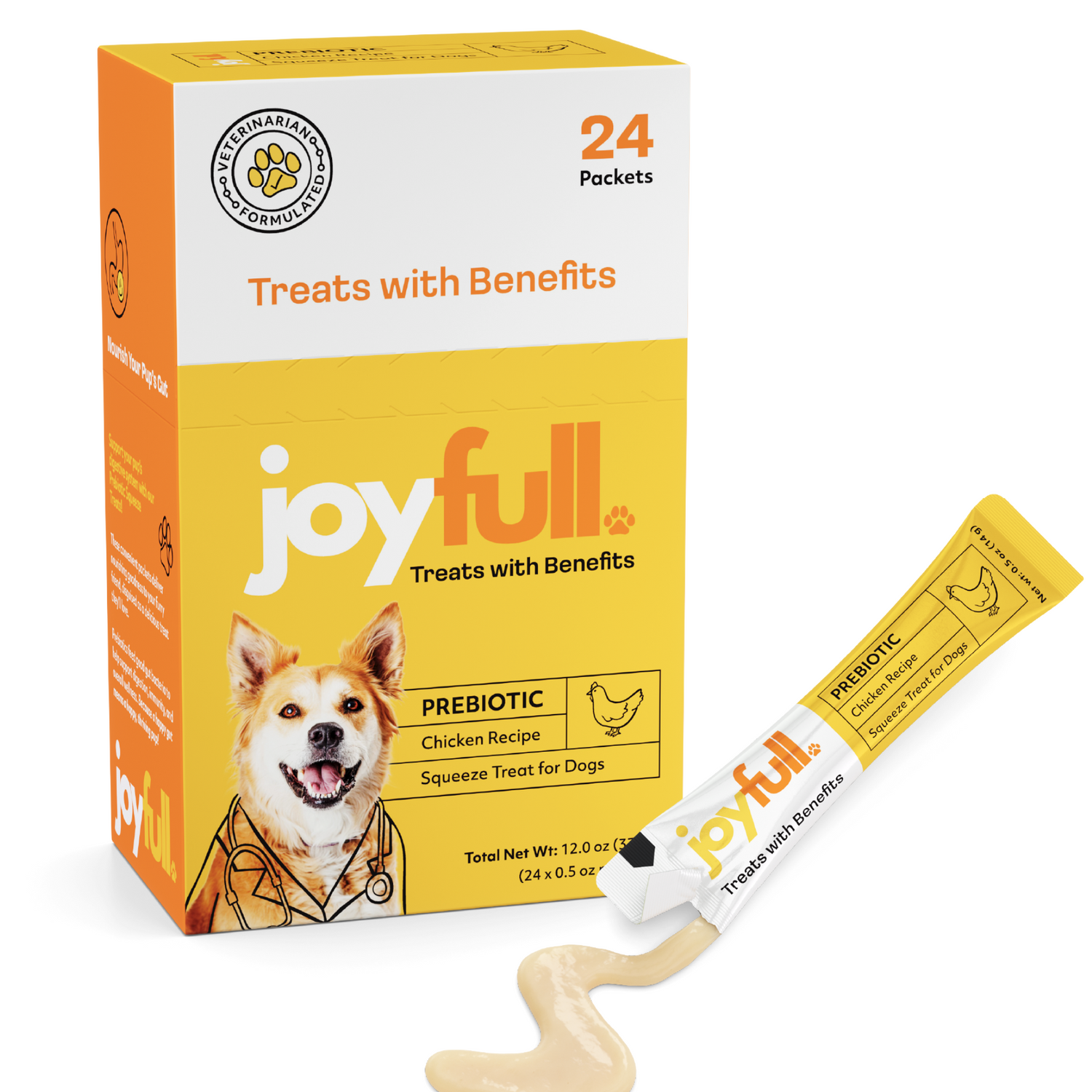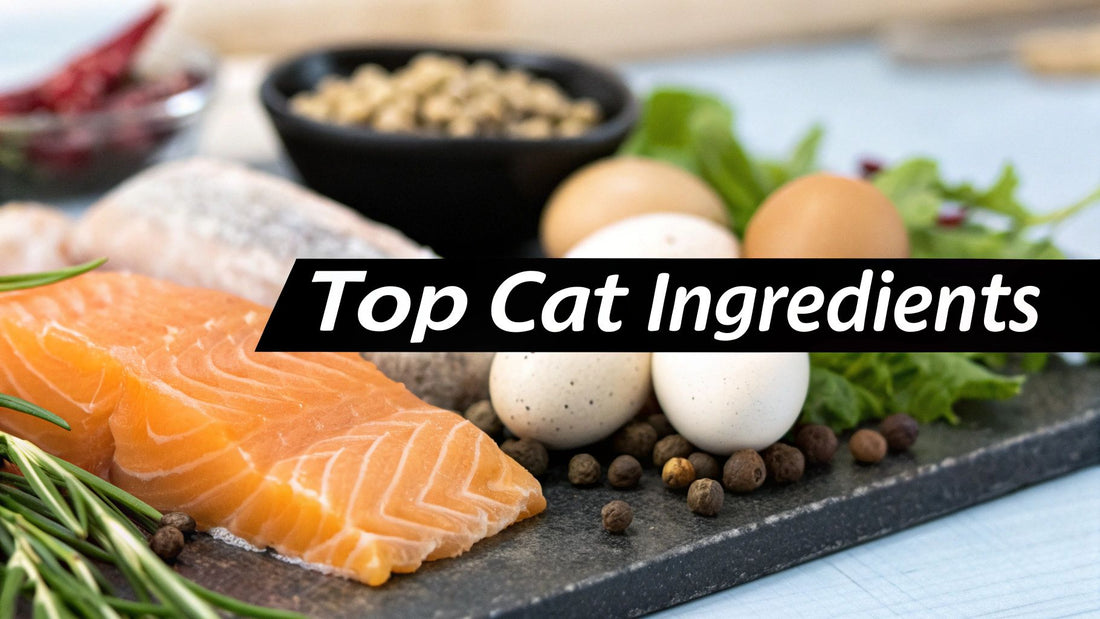
8 Best Ingredients for Cat Food to Look for in 2025
As a devoted cat parent, you know that nutrition is the cornerstone of a long, vibrant life for your feline companion. But navigating the pet food aisle can feel overwhelming. With labels full of complex terms and marketing jargon, how can you be sure you're making the best choice? This guide cuts through the noise. We'll break down the absolute best ingredients for cat food, explaining precisely why each one is crucial for your cat's health, from building lean muscle to maintaining a glossy coat and supporting a healthy immune system.
Cats are obligate carnivores, meaning their bodies are designed to thrive on a diet rich in animal-based proteins and fats. Understanding what to look for on an ingredients panel allows you to confidently choose a food that mirrors this natural, high-protein diet. Moving beyond flashy packaging to analyze the core components is the single most important step you can take for your cat's well-being. To delve deeper into understanding optimal nutrition, refer to our comprehensive guide on the best cat food ingredients for a healthy cat.
In this article, we will explore the 8 powerhouse ingredients that should be at the top of every cat food label, providing you with the knowledge to select a truly superior formula.
1. Deboned Chicken
When scanning a cat food label, seeing deboned chicken listed as the first ingredient is an excellent indicator of a high-quality product. As obligate carnivores, cats have a biological requirement for animal-based protein to survive and thrive. Deboned chicken provides a highly digestible, complete protein source that supplies all the essential amino acids a cat needs, including crucial ones like taurine, which is vital for heart health and vision.
This ingredient is precisely what it sounds like: fresh chicken meat with the bones removed. Its inclusion means your cat is getting protein in a natural, moisture-rich state, closely mirroring what their wild ancestors would have consumed. This high-quality protein is fundamental to building and maintaining lean muscle mass, supporting immune function, and fueling daily energy needs.
How to Identify Quality Chicken in Cat Food
To ensure you're selecting the best food, look for "deboned chicken," "chicken," or "chicken meat" at the very top of the ingredients list. This placement signifies it is the most abundant ingredient by weight. Brands like Orijen Cat & Kitten Dry Food and Wellness CORE Natural Grain-Free are excellent examples that prioritize this gold-standard protein.
Here is a quick reference summarizing the key nutritional benefits of deboned chicken for cats.
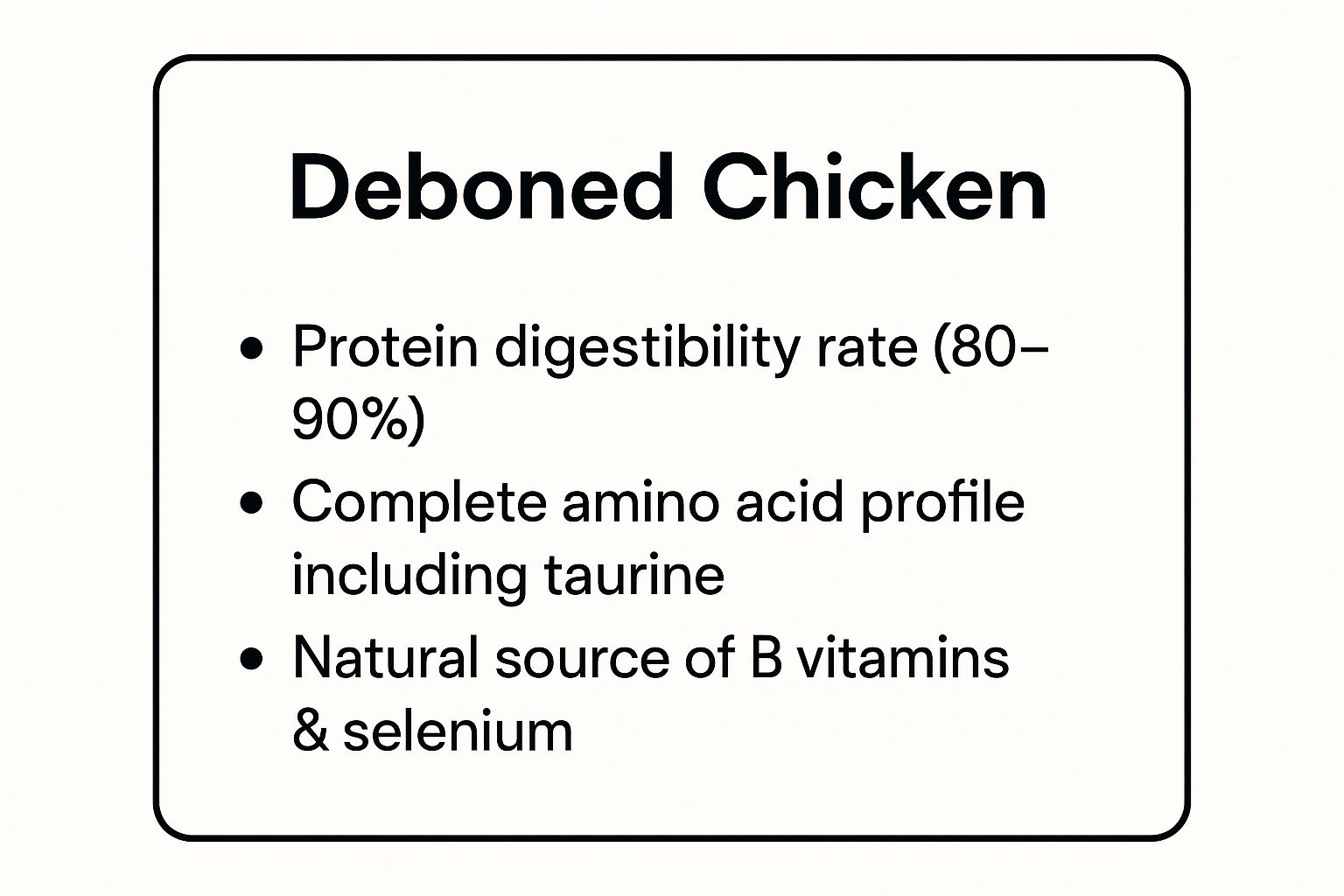
The data highlights that deboned chicken isn't just a palatable option; it's a nutritionally dense and efficient source of the building blocks your cat needs.
Actionable Tips for Selection
- Check the Protein Percentage: Aim for a guaranteed analysis that shows a minimum of 30% crude protein for dry food.
- Combine with Chicken Meal: While deboned chicken is excellent, seeing chicken meal further down the list is also a positive. Chicken meal is a rendered, concentrated protein source that boosts the overall amino acid content.
- Rotate Proteins: To prevent potential food sensitivities and provide a broader range of nutrients, consider rotating your cat’s food with other high-quality proteins like turkey or fish.
2. Salmon
Salmon is a premium, highly palatable protein source that offers significant nutritional benefits beyond just amino acids. As a fatty fish, it is exceptionally rich in omega-3 fatty acids, particularly eicosapentaenoic acid (EPA) and docosahexaenoic acid (DHA). These specific fats are crucial for a cat’s overall health, supporting cognitive function, reducing inflammation, promoting joint health, and contributing to a lustrous, healthy skin and coat.
This ingredient provides another excellent option for obligate carnivores, delivering a complete protein profile necessary for muscle maintenance and energy. Because it is less common in cat food than chicken or beef, salmon can also serve as a novel protein source. This makes it an ideal choice for cats that have developed sensitivities or allergies to more conventional proteins, helping to alleviate dietary-related issues like itchy skin or digestive upset.
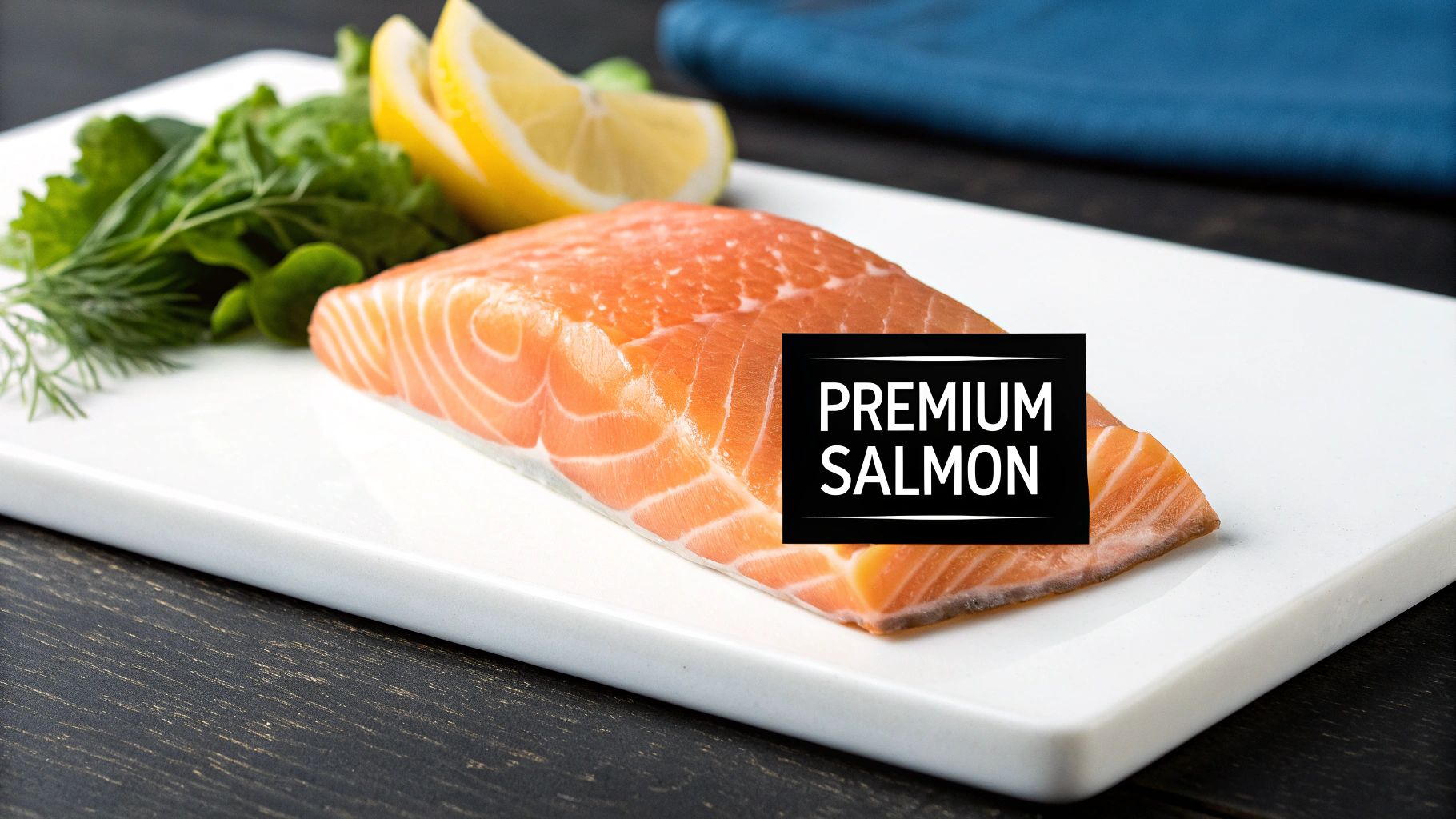
How to Identify Quality Salmon in Cat Food
To ensure your cat reaps the full benefits, look for "salmon," "deboned salmon," or "salmon meal" high on the ingredient list. The presence of salmon indicates it is a primary component of the recipe. Brands like Taste of the Wild Rocky Mountain Recipe and Instinct Original Grain-Free Salmon are well-regarded for featuring this high-quality fish as a foundational ingredient, making them a top choice when searching for the best ingredients for cat food.
The inclusion of salmon highlights a food's commitment to not only providing essential protein but also powerful, anti-inflammatory fats that support a cat's well-being from the inside out.
Actionable Tips for Selection
- Choose Wild-Caught: Whenever possible, opt for foods specifying "wild-caught salmon." It generally has a superior nutritional profile with a better ratio of omega-3 to omega-6 fatty acids compared to farm-raised varieties.
- Look for Salmon Oil: The presence of "salmon oil" further down the ingredient list is a strong positive, as it boosts the concentration of beneficial EPA and DHA.
- Introduce Gradually: If your cat is new to fish-based proteins, introduce the food slowly over 7-10 days to prevent any potential digestive upset.
3. Chicken Liver
When scanning cat food labels, finding chicken liver among the top ingredients signals an extremely nutrient-dense formula. This organ meat serves as nature’s multivitamin for cats, delivering concentrated stores of vitamin A, iron, and B vitamins in a single ingredient.
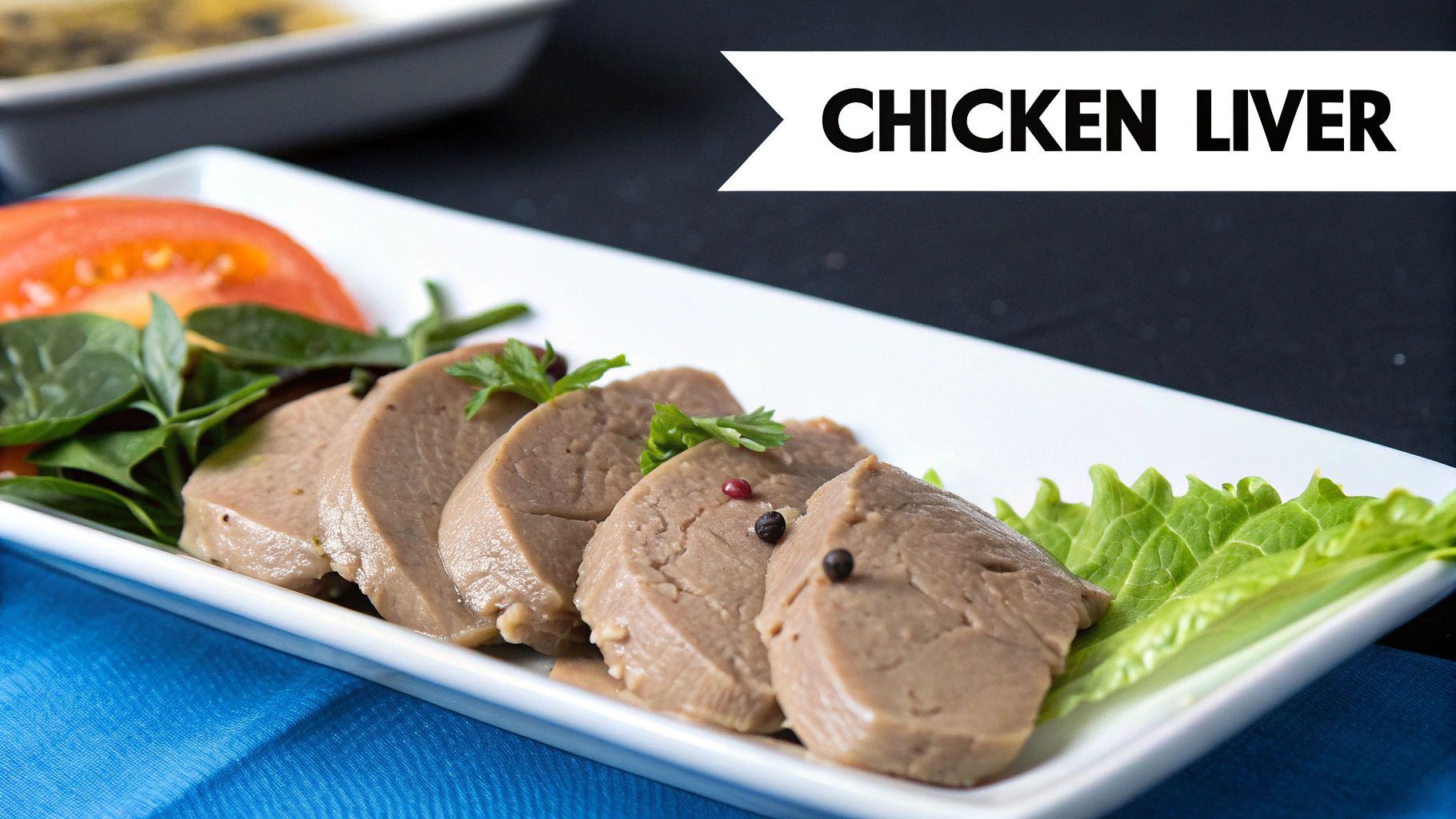
Chicken liver closely replicates what wild felines consume, offering nutrients that muscle meat alone cannot provide. It supports healthy vision, red blood cell formation, and metabolic energy—benefits that make it one of the best ingredients for cat food.
How to Identify Quality Chicken Liver in Cat Food
To confirm quality, look for “chicken liver” in the first five ingredients. Leading brands like Wellness CORE Grain-Free, Blue Buffalo Wilderness, Nulo FreeStyle Grain-Free, and Nature’s Logic Natural Recipes highlight this organ meat prominently to ensure optimum vitamin and mineral intake.
When and Why to Use Chicken Liver
- Ideal for growing kittens and pregnant or nursing cats to meet elevated nutrient demands
- Essential in homemade cat food recipes for balanced vitamin A and iron levels
- Valuable as a training treat when freeze-dried, rewarding good behavior without fillers
Actionable Tips for Selection
- Keep liver under 5–10% of total diet to avoid vitamin A toxicity
- Verify ingredient order: chicken liver should not be buried deep in the list
- Use freeze-dried chicken liver treats for supplemental nutrition and training
- Consult a veterinarian when adding organ meats to homemade diets
- Rotate with other organ meats to prevent nutrient overload and ensure diversity
4. Sweet Potato
While cats are carnivores, a small amount of carefully selected carbohydrate can offer significant benefits. Sweet potato stands out as an excellent source of complex carbohydrates, providing sustained energy and valuable dietary fiber. Unlike simple grains that can cause blood sugar spikes, sweet potatoes are digested slowly, making them a gentle and effective ingredient.
This vibrant root vegetable is packed with nutrients, including beta-carotene (a precursor to Vitamin A), potassium, and essential vitamins. The high fiber content is particularly beneficial for promoting healthy digestion and regular bowel movements. This makes it an ideal inclusion for cats with sensitive stomachs or senior felines who may experience digestive sluggishness. It adds both nutritional substance and functional support to a well-rounded diet.
How to Identify Quality Sweet Potato in Cat Food
To ensure your cat reaps the full benefits, look for "sweet potato" listed after the primary protein sources on the ingredients panel. This confirms it is included in appropriate, smaller quantities relative to the essential animal protein. Brands like Merrick Purrfect Bistro, Wellness Complete Health, and Blue Buffalo Life Protection Formula are great examples of formulas that properly integrate this beneficial vegetable.
Actionable Tips for Selection
- Look for "Whole" Ingredients: Prioritize formulas that list "sweet potato" rather than "sweet potato meal" or "sweet potato product" to ensure maximum nutrient integrity.
- Check Ingredient Placement: The sweet potato should never be the first ingredient. It should follow high-quality animal proteins, reinforcing its role as a supportive, not primary, component.
- Consider Your Cat's Needs: While beneficial for digestion, sweet potato is a carbohydrate. Avoid foods high in this ingredient if your cat is diabetic or has significant weight management issues, and consult your vet.
5. Fish Oil (Salmon Oil)
When looking for an ingredient that provides a powerful boost to your cat’s well-being, fish oil, especially salmon oil, is a top contender. This valuable addition is a concentrated source of omega-3 fatty acids, specifically eicosapentaenoic acid (EPA) and docosahexaenoic acid (DHA). Cats cannot efficiently produce these essential fatty acids on their own, making dietary sources critical for their health.
Fish oil is renowned for its anti-inflammatory properties, which support joint health and mobility, particularly in senior cats. Furthermore, EPA and DHA are crucial for maintaining a healthy, shiny coat and supple skin, reducing dryness and flakiness. These fatty acids also play a vital role in cognitive function and retinal development, making fish oil one of the best ingredients for cat food for cats of all life stages.
How to Identify Quality Fish Oil in Cat Food
To ensure your cat gets the maximum benefit, look for cat foods that explicitly list "salmon oil" or "fish oil" in the ingredient panel, rather than just "fish." Some brands even fortify their formulas with it. High-quality examples include Wellness CORE formulas and brands like Grizzly Pet Products, which are known for prioritizing this supplement. Alternatively, you can add it as a liquid supplement to your cat's existing food. For excellent skin and coat health, consider supplementing your cat's diet with beneficial omega-3 fish oil supplements for skin and coat health.
This video explains the extensive benefits of omega-3s for pets.
Including this nutrient-dense oil can transform your cat's health from the inside out.
Actionable Tips for Selection
- Choose Wild-Caught Sources: Whenever possible, opt for oil derived from wild-caught, cold-water fish like salmon, as it typically has a higher concentration of omega-3s.
- Look for Purity Testing: Reputable brands like Nordic Naturals Omega-3 Pet will have their products third-party tested for heavy metals and other contaminants to ensure purity and safety.
- Start Small and Store Properly: When introducing fish oil as a supplement, start with a small dose and gradually increase it. Always store the oil in the refrigerator after opening to prevent it from going rancid.
6. Taurine
Unlike many other ingredients on this list, taurine isn't a source of calories or protein in the traditional sense; it is a vital amino acid that is absolutely non-negotiable for feline health. Cats are unique in that they cannot produce sufficient amounts of taurine on their own, making it an essential dietary component. A deficiency can lead to severe and irreversible health conditions, including dilated cardiomyopathy (a serious heart disease), feline central retinal degeneration leading to blindness, and reproductive failure.
Taurine is naturally abundant in animal-based muscle tissues, particularly the heart and brain. Its presence in a cat food formula signifies that the manufacturer understands the fundamental, species-specific needs of cats. As one of the best ingredients for cat food, its inclusion is a marker of a nutritionally complete and safe diet. Without adequate taurine, a cat simply cannot thrive, regardless of how high the protein percentage is.
How to Identify Quality Taurine Supplementation
Ensuring your cat's food has adequate taurine is straightforward. It will be listed in the ingredients, often as "taurine," typically near the vitamins and minerals. All commercially available foods that meet the Association of American Feed Control Officials (AAFCO) guidelines for "complete and balanced" nutrition will contain sufficient levels. Brands like Royal Canin Feline Health Nutrition and Hill's Science Diet meticulously formulate their recipes to meet these critical requirements.
For a deeper dive into what makes a cat food formula complete, you can find more information on how to choose the right cat food.
Actionable Tips for Selection
- Check the Guaranteed Analysis: AAFCO recommends a minimum of 0.1% taurine in dry cat food and 0.2% in wet (canned) food on a dry matter basis. This information is usually found in the guaranteed analysis panel on the packaging.
- Confirm "Complete and Balanced" Labeling: Always look for the AAFCO nutritional adequacy statement on the bag or can. This is your guarantee that the food contains all necessary nutrients, including taurine.
- Be Cautious with Homemade Diets: If you prepare homemade food for your cat, consulting with a veterinary nutritionist is critical to ensure you are supplementing with the correct amount of taurine. Natural sources alone may not be sufficient or consistent.
7. Probiotics (Lactobacillus acidophilus)
While not a core nutrient like protein or fat, the inclusion of probiotics in a cat food formula is a strong sign of a thoughtfully crafted diet that supports overall well-being. Probiotics are beneficial, live microorganisms that promote a healthy balance of gut bacteria. Lactobacillus acidophilus is one of the most studied and effective strains for felines, playing a crucial role in digestive health and immune system support.
These "good bacteria" aid in breaking down food and absorbing nutrients more efficiently. They also help to crowd out harmful pathogens, creating a fortified gut environment. This is especially beneficial for cats with sensitive stomachs, those prone to digestive upset, or kittens and senior cats whose gut flora may be less stable. A healthy gut microbiome is directly linked to a robust immune response, helping your cat fend off illness.
How to Identify Quality Probiotics in Cat Food
To ensure the probiotics are effective, the label should guarantee a certain number of live cultures, often measured in Colony-Forming Units (CFUs), at the time of consumption. Quality brands like Purina Pro Plan LIVECLEAR and Hill's Prescription Diet i/d often fortify their formulas with these beneficial microbes. Some products, like FortiFlora by Purina Pro Plan Veterinary Diets, are designed as supplements to add to any food.
Here's a quick reference on why probiotics are one of the best ingredients for cat food.
Probiotics contribute to a balanced gut microbiome, which is foundational to a cat's digestive efficiency, nutrient absorption, and overall immune health. They are a proactive ingredient for long-term wellness.
The presence of probiotics shows a brand is focused not just on basic nutrition but on optimizing your cat's internal systems for peak health.
Actionable Tips for Selection
- Look for Guaranteed Live Cultures: Check the "Guaranteed Analysis" for a specific CFU count to ensure the product contains a viable amount of beneficial bacteria.
- Store Food Properly: To protect the live cultures, store probiotic-fortified food in a cool, dry place away from direct sunlight.
- Introduce Gradually: When starting a new food with probiotics, transition your cat over a 7-10 day period to allow their digestive system to adjust. For cats needing extra support, you might consider adding a targeted supplement. Learn more about the best supplements for cats on joyfullpet.com.
8. Chicken Meal
While fresh meat is excellent, seeing chicken meal on a cat food label is a strong sign of a high-protein, nutrient-dense formula. Chicken meal is a rendered ingredient, which means fresh chicken tissue has been cooked to remove water and fat. The result is a highly concentrated, dry protein powder that contains up to 300% more protein than its fresh counterpart by weight. This makes it an incredibly efficient ingredient for boosting the overall protein content of dry cat food.
As obligate carnivores, cats need a diet rich in animal-based protein, and chicken meal delivers this in a stable, consistent form. Unlike fresh chicken, which is about 70% water and loses volume during cooking, chicken meal's nutritional profile remains intact. This ingredient provides the essential amino acids necessary for lean muscle maintenance, immune system support, and sustained energy. It's a cornerstone of many premium, high-protein cat foods.
How to Identify Quality Chicken Meal in Cat Food
To ensure you're choosing a high-quality product, look for a specifically named source, such as "chicken meal," high up on the ingredients list. Avoid generic terms like "poultry meal" or "meat meal," which can be from unspecified and lower-quality sources. Brands like Acana Wild Prairie and Blue Buffalo Wilderness frequently use chicken meal to create their protein-rich, grain-free formulas.
Here is a quick reference summarizing the key nutritional benefits of chicken meal for cats.
This data shows that chicken meal is one of the most effective and concentrated sources for creating the best ingredients for cat food with high protein levels.
Actionable Tips for Selection
- Look for Named Sources: Always choose foods that specify "chicken meal," "turkey meal," or "salmon meal" instead of vague terms like "animal meal."
- Balance with Fresh Meat: An ideal formula often includes both a fresh meat source (like deboned chicken) for palatability and a meat meal for concentrated protein.
- Check Protein Levels: Chicken meal is key to achieving high protein percentages in dry food. To learn more about protein-packed options, discover some of the best high-protein cat treats on joyfullpet.com.
Key Ingredient Comparison for Cat Food
| Item | Implementation Complexity 🔄 | Resource Requirements ⚡ | Expected Outcomes 📊 | Ideal Use Cases 💡 | Key Advantages ⭐ |
|---|---|---|---|---|---|
| Deboned Chicken | Moderate – requires fresh sourcing and proper storage | High – fresh meat, refrigeration needed | High digestibility, complete amino acids | Premium cat foods, lean muscle support, hypoallergenic diets | Highly palatable; natural taurine & B vitamins |
| Salmon | Moderate to High – sourcing wild-caught preferred | High – costly, fresh/premium ingredient | Omega-3 rich, anti-inflammatory benefits | Cats with allergies, cognitive & skin health diets | Rich in EPA/DHA; novel protein for sensitivities |
| Chicken Liver | Moderate – careful portioning to avoid toxicity | Moderate – easier to source than fresh meat | Nutrient-dense organ meat benefits | Growing kittens, pregnant cats, immune support | Extremely nutrient-dense; supports vision & reproduction |
| Sweet Potato | Low – common ingredient, requires cooking | Moderate – plant-based, longer shelf life | Sustained energy, digestive support | Senior cats, sensitive digestion, grain-free options | Complex carbs; fiber-rich; low glycemic index |
| Fish Oil (Salmon Oil) | Low to Moderate – supplement form, needs cold storage | Moderate – specialized extraction | Improves coat, joints, cognition | Supplement to improve coat & joint health | Concentrated EPA/DHA; easy absorption |
| Taurine | Low – usually supplement added during formulation | Low – synthetic or natural supplementation | Prevents serious health issues | All cat diets, critical nutrient supplementation | Essential amino acid; prevents fatal deficiencies |
| Probiotics | Moderate – requires viability maintenance | Moderate – freeze-dried or live cultures | Improved digestion and immunity | Cats with sensitive stomachs, post-antibiotics | Supports gut health, immune function |
| Chicken Meal | Moderate – processed ingredient, stable storage | Moderate – dried, stable protein source | Consistent, concentrated protein | Dry foods, high-protein formulations | High protein density; long shelf life |
Empowering Your Choices for a Healthier Cat
Navigating the world of cat nutrition can feel overwhelming, but armed with the right knowledge, you can transform from a confused consumer into a confident advocate for your feline’s health. This guide has equipped you with the ability to look beyond marketing claims and focus on what truly matters: the ingredient list. Understanding the best ingredients for cat food is the single most powerful tool you have to ensure your cat thrives for years to come.
Remember, the core principle is to feed your cat as nature intended. As obligate carnivores, their bodies are designed to derive nutrients primarily from animal sources. This is why our list emphasized high-quality, named animal proteins like deboned chicken, nutrient-dense organ meats such as chicken liver, and concentrated sources like chicken meal. These ingredients provide the essential amino acids, including the non-negotiable taurine, that form the building blocks for strong muscles, a healthy heart, and a robust immune system.
Key Takeaways for Your Next Food Purchase
Your next trip to the pet store doesn’t have to be a guessing game. Keep these actionable insights in your back pocket:
- Protein First, Always: The very first ingredient on the label should be a named animal protein (e.g., "Salmon," not "fish meal"). This is the most reliable indicator of a high-quality, meat-based diet.
- Embrace Healthy Fats: Look for the inclusion of omega-rich fats like Fish Oil (specifically Salmon Oil). These are not just for a shiny coat; they are crucial for cognitive function, joint health, and reducing inflammation.
- Digestive Health is Foundational: The presence of beneficial probiotics, such as Lactobacillus acidophilus, signifies a formula designed for gut health, which is the cornerstone of overall wellness and nutrient absorption.
- Carbohydrates with a Purpose: While cats have limited carbohydrate needs, functional sources like sweet potatoes can provide valuable fiber and antioxidants, but they should never dominate the ingredient list.
Making an informed decision about your cat's diet is a profound act of love. It directly impacts their energy levels, longevity, and quality of life. By prioritizing these premium ingredients, you're not just filling their bowl; you're investing in their future health and happiness. Of course, a well-rounded approach to wellness extends beyond nutrition. For a holistic view, it's also important to follow useful pet care tips for their overall safety and health. Ultimately, the confidence you gain from deciphering ingredient labels empowers you to make the best possible choice for your cherished companion, ensuring a vibrant and joyful life together.
At Joyfull, we live by these principles. We craft our recipes by selecting only the purposeful, high-quality ingredients discussed here because we believe superior nutrition is the foundation of a happy life. Explore our formulas and see the difference a 'no-BS' ingredient philosophy makes at Joyfull.
